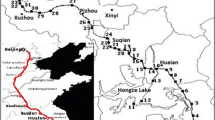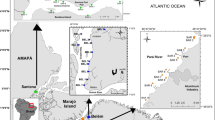Abstract
The presence of polylcyclic aromatic hydrocarbons (PAHs) in surface sediments of Barigui River was investigated. PAHs are considered highly toxic and persistent compounds because of their structure. They originate from incomplete combustion of fossil fuels or biomass. The Barigui River crosses the metropolitan region of Curitiba, and some regions are highly polluted and located near the possible sources of pollution. The results showed that concentrations of total PAHs ranged from 44.6 to 880.2 ng g−1, and the highest values were found at the sites previously investigated and identified as critically polluted. At sites located away from the traffic and possible pollution sources, the total PAHs was lower, 44.6 ng g−1. Due to their hydrophobic character, sediments with high silt and clay content retain greater amounts of PAHs. The granulometric composition of the sediments revealed that most of them are composed basically by silt and clay, and those samples showed high concentration of PAHs. The organic carbon content also confirms this observation. The other sites investigated showed a high capacity to adsorb hydrophobic compounds mainly due to the granulometric composition and organic matter that adsorb poorly water soluble compounds. Finally, we found that the main sources of PAHs are petrogenic; however, at some sites, it is hard to confirm this pattern, and possibly, a mixture of the source would be more appropriate.



Similar content being viewed by others
References
Alves, J. P. H., Passos, E. A. P., & Garcia, C. A. B. (2007). Metals and acid volatile sulfide in sediment cores from the Sergipe River Estuary, Northeast, Brazil. Journal of the Brazilian Chemical Society, 18, 748–758.
Barra, R., Quiroz, R., Saez, K., Araneda, A., Urrutia, R., & Popp, P. (2009). Sources of polycyclic aromatic hydrocarbons (PAHs) in sediments of the Biobio River in south central Chile. Environmental Chemistry Letters (in press). doi:10.1007/s10311-008-0148-z.
Baumard, P., Budzinski, H., Michon, Q., Garrigues, P., Burgeot, T., & Bellocq, J. (1998). Origin and bioavailability of PAHs in the Mediterranean Sea from mussel and sediment records. Estuarine, Coastal and Shelf Science, 47, 77–90. doi:10.1006/ecss.1998.0337.
Budzinski, H., Bellocq, I. J. J., Pierard, C., & Garrigues, P. (1997). Evaluation of sediment contamination by polycyclic aromatic hydrocarbons in the Gironde estuary. Marine Chemistry, 58, 85–97. doi:10.1016/S0304-4203(97)00028-5.
Butler, J. D., & Crossley, F. (1981). Reactivity of polycyclic aromatic hydrocarbons adsorbed on soot particles. Atmospheric Environment, 15, 91–94. doi:10.1016/0004-6981(81)90129-3.
Caricchia, A. M., Chiavarini, S., & Pezza, M. (1999). Polycyclic aromatic hydrocarbons in the atmospheric particulate matter in the city of Naples Italy. Atmospheric Environment, 33, 3731–3738. doi:10.1016/S1352-2310(99)00199-5.
Cerniglia, C. E., & Heitkamp, M. A. (1989). Microbial degradation of PAH in the aquatic environment. In U. Vanarasi (Ed.), Metabolism of polycyclic aromatic hydrocarbons in the aquatic environment (pp. 41–68). Boca Raton, FL: CRC.
Chen, B., Xuan, X., Zhu, L., Wang, J., Gao, Y., Yang, K., et al. (2004). Distribuition of polycyclic aromatic hydrocarbons in surface waters, sediments and soils of Hangzhou City, China. Water Research, 38, 3558–3567. doi:10.1016/j.watres.2004.05.013.
Dickhut, R. M., Canuel, E. A., Gustafson, K. E., Liu, K., Arzayus, K. M., Walter, S. E., et al. (2000). Automotive sources of carcinogenic polycyclic aromatic hydrocarbons associated with particulate matter in the Chesapeake Bay Region. Environmental Science & Technology, 34, 4635–4640. doi:10.1021/es000971e.
Doong, R., & Lin, Y. (2004). Characterization and distribution of polycyclic aromatic hydrocarbon contaminations in surface sediment and water from Gao-ping River, Taiwan. Water Research, 38, 1733–1744. doi:10.1016/j.watres.2003.12.042.
Fasnacht, M. P., & Blough, N. V. (2002). Aqueous photodegradation of polycyclic aromatic hydrocarbons. Environmental Science & Technology, 36, 4364–4369. doi:10.1021/es025603k.
Froehner, S. Maceno, M. (2009). Assessment of bioaccumulation of bifenyls in the trophic chain of a coastal area of Parana, Brazil. Environmental Monitoring and Assessment (in press).
Froehner, S., & Martins, R. F. (2008a). Assessment of fate and bioaccumulation of benzo(a)pirene by modeling. Quimica Nova, 31(8), 1089–1093.
Froehner, S., & Martins, R. F. (2008b). Evaluation of the chemical composition of sediments from the Barigüi river in Curitiba, Brazil. Quimica Nova, 31(8), 2020–2026.
Froehner, S., Martins, R. F., & Errera, M. R. (2009). Assessment of fecal sterols in Barigui River sediments in Curitiba, Brazil. Environmental Monitoring and Assessment (in press). doi:10.1007/s10661-008-0559-0.
Gigliotti, C. L., Brunciak, P. A., Dachs, J., Glenn IV, T. R., Nelson, E. D., Totten, L. A., et al. (2002). Air–water exchange of polycyclic aromatic hydrocarbons in the New York–New Jersey, USA, harbor estuary. Environmental Toxicology and Chemistry, 21, 235–244. doi:10.1897/1551-5028(2002)021<0235:AWEOPA>2.0.CO;2.
Guzzella, L., & DePaolis, A. (1994). Polycyclic aromatic hydrocarbons in sediments of the Adriatic Sea. Marine Pollution Bulletin, 28, 159–165. doi:10.1016/0025-326X(94)90392-1.
Hinga, K. R. (2003). Degradation rates of low molecular weight PAH correlate with sediment TOC in marine subtidal sediments. Marine Pollution Bulletin, 46, 466–474. doi:10.1016/S0025-326X(02)00459-9.
Khillare, P. S., Agarwal, T., & Shridhar, V. (2006). PAHs Contamination in Bank sediment of the Yamuna River, Delhi, India. Environmental Monitoring and Assessment, 123, 151–166. doi:10.1007/s10661-006-9189-6.
Kipopoulou, A. M., Manoli, E., & Samara, C. (1999). Bioconcentration of polycyclic aromatic hydrocarbons in vegetables grown in an industrial area. Environmental Pollution, 106, 369–380. doi:10.1016/S0269-7491(99)00107-4.
Macleod, M., McKone, T. E., Foster, K., Maddalena, R., Parkenton, T., & Mackay, D. (2004). Applications of contaminant fate and bioaccumulation models in assessing ecological risks of chemicals: a case study for gasoline hydrocarbons. Environmental Science & Technology, 38, 6225–6233. doi:10.1021/es049752+.
Perugini, M., Visciano, P., Giammarino, A., Manera, M., Di Nardo, W., & Amorena, M. (2007). Polycyclic aromatic hydrocarbons in marine organisms from the Adriatic Sea, Italy. Chemosphere, 66, 1904–1910. doi:10.1016/j.chemosphere.2006.07.079.
Peyton, B. M., Viamajala, S., Richards, L. A., & Petersen, J. N. (2007). Solubilization, solution equilibria, and biodegradation of PAH’s under thermophilic conditions. Chemosphere, 66, 1094–1106. doi:10.1016/j.chemosphere.2006.06.059.
Ruttenberg, K. C., & Goni, M. A. (1997). Phosphorus distribution, C:N:P ratios, and δ13Coc in artic, temperate, and tropical coastal sediments: tools for characterizing bulk sedimentary organic matter. Marine Geology, 139, 123–145. doi:10.1016/S0025-3227(96)00107-7.
Savinov, V. M., Savinova, T. N., Matishov, G. G., Dahle, S., & Naes, K. (2003). Polycyclic aromatic hydrocarbons (PAHs) and organo-chlorines (OCs) in bottom sediments of the Guba Pechenga, Barents Sea, Russia. The Science of the Total Environment, 306, 39–56. doi:10.1016/S0048-9697(02)00483-7.
Simcik, M. F., Eisenreich, S. J., & Lioy, P. J. (1999). Source apportionment and source/sink relationships of PAHs in the coastal atmosphere of Chicago and Lake Michigan. Atmospheric Environment, 33, 5071–5079. doi:10.1016/S1352-2310(99)00233-2.
Sirece, M. A., Marty, J. C., Saliot, A., Aparicio, X., Grimalt, J., & Albaiges, J. (1987). Aliphatic and aromatic hydrocarbonsin different sized aerosols over the Mediterranean Sea: occurrence and origin. Atmospheric Environment, 21, 2247–2259. doi:10.1016/0004-6981(87)90356-8.
Sivan, P., Datta, G. C., & Singh, R. R. (2008). Aromatic biomarkers as indicators of source, depositional environment, maturity and secondary migration in the oils of Cambay Basin, India. Organic Geochemistry, 39, 1620–1630. doi:10.1016/j.orggeochem.2008.06.009.
Smith, J. N., & Levy, E. M. (1990). Geochronology of polycyclic aromatic hydrocarbon contamination in sediments of the Saguenay Fjord. Environmental Science & Technology, 24, 874–879. doi:10.1021/es00076a013.
Soclo, H. H., Garrigues, P. H., & Ewald, M. (2000). Origino f polycyclic aromatic hydrocarbons (PAHs) in coastal marine sediments: Case studies in Cotonou (Benin) and Aquitaine (France) areas. Marine Pollution Bulletin, 40, 387–396. doi:10.1016/S0025-326X(99)00200-3.
Subramanian, V., Moturi, O. C. Z., & Rawat, M. (2005). Distribuition and partitioning of phosphorus in solid waste and sediments from drainage canals in the industrial belt of Dheli, India. Chemosphere, 60, 237–244. doi:10.1016/j.chemosphere.2004.11.032.
Yang, H. H., Chiang, C. F., Lee, W. J., Hwang, K. P., & Wu, E. M. Y. (1999). Size distribution and dry deposition of road dust PAHs. Environment International, 25, 585–597. doi:10.1016/S0160-4120(99)00036-7.
World Health Organization (WHO). (1998). Selected non-heterocyclic polycyclic aromatic hydrocarbons, Environmental Health Criteria 202, United Nations Environment Programme, International Labour Organization, Geneva. Retrieved September 2008 from http://www.inchem.org/documents/ech/ech202.htm.
Toxnet Data Base. (2007). Retrieved August 2008 from http://toxnet.nlm.nih.gov.
Viguri, J., Verde, J., & Irabien, A. (2002). Environmental assessment of polycyclic aromatic hydrocarbons (PAH) in surface sediments of the Santander Bay, Northern Spain. Chemosphere, 48, 157–165.
Acknowledgments
Thanks are due to Mr. Luis Carlos Barbosa to help us in the field works. We also thank the Mineral Laboratory Analysis (LAMIR-UFPR) for the granulometric analysis and CNPq for financial support (Grant 409955/2006-0).
Author information
Authors and Affiliations
Corresponding author
Rights and permissions
About this article
Cite this article
Froehner, S., Zeni, J., Cardoso da Luz, E. et al. Characterization of Granulometric and Chemical Composition of Sediments of Barigui River Samples and their Capacity to Retain Polycyclic Aromatic Hydrocarbons. Water Air Soil Pollut 203, 381–389 (2009). https://doi.org/10.1007/s11270-009-0020-1
Received:
Accepted:
Published:
Issue Date:
DOI: https://doi.org/10.1007/s11270-009-0020-1




